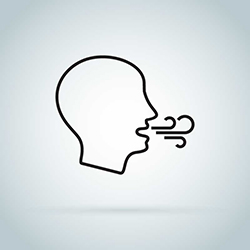Three Simple Breathing Exercises for COPD

Do you ever feel it – that elephant sitting on your chest? Out of nowhere, the air is stuck and comes out with a painful, wheezy sound. You are a fish out of water. You. Just. Can’t. Breathe. What do you do?
Don’t panic – in addition to using your rescue inhaler, there is a simple exercise that can help you get air easier when you have trouble breathing. Practice it when you are feeling well to make sure it is easy to do when you are having an “episode” and to help make your muscles stronger which may lower the number of “episodes” you have.
Exercise #1: Pursed-lip breathing
Pursed-lip breathing can be especially helpful before you start an activity. It can also be used any time you feel short of breath. You can do this exercise by following these steps:
• Breathe in through your nose. Use the muscles in your abdomen to help fill your lungs with air.
• Slowly breathe out through your mouth with your lips slightly puckered. You should make a quiet hissing sound as you breathe out.
• Try to take twice as long to breathe out as it did to breathe in. This helps you get rid of as much air from your lungs as possible.
• Repeat this exercise several times. Once you are used to doing pursed-lip breathing, you can do it any time you need more air.
Strengthening your lungs
In addition to the Pursed-Lip Breathing, these next two exercises can help make your breathing muscles stronger to help prevent “episodes.” Talk to your health care provider about when and how often to do them. Write down your questions so you remember to ask them during your visits.
Exercise #2: Deep breathing and coughing
Take a deep breath and hold it for as long as you can. Let the air out and then cough strongly. Deep breaths help open your airway. You may be given an incentive spirometer to help you take deep breaths. Put the plastic piece in your mouth and take a slow, deep breath. Then let the air out and cough. Repeat these steps 10 times every hour. This will decrease your risk for a lung infection.
Exercise #3: Diaphragmatic breathing
This exercise will help strengthen the muscles that you use to breathe. You can do this exercise by following these steps:
• Place one hand just below your ribs. Place your other hand in the middle of your chest over your breastbone.
• Breathe in slowly through your nose, as deeply as you can.
• Breathe out slowly through pursed lips. As you breathe out, tighten the muscles just below your ribs. Use your hand to gently push in and up while you tighten the muscles.
• Diaphragmatic breathing takes practice. You may need to practice this many times a day. Slowly increase the amount of time you spend during each practice session.
